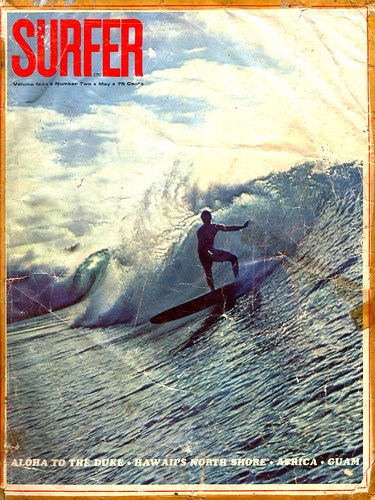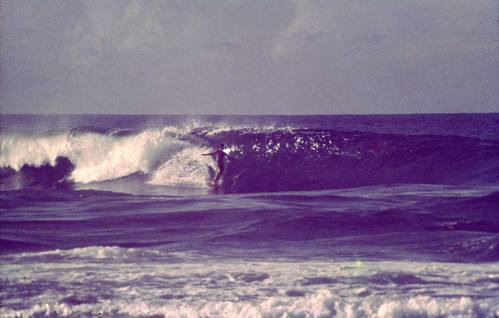View more photos for the Surfing: Early History on Guam entry here.
Riding the waves
People first started riding the waves on Guam in the early 1960s. Guam surfers from that era remember high school industrial arts teacher John Bylander, Australian Cable Company employee Jim Keenan, and Rick Value, son of a local businessman, as among those on the vanguard of serious surfing across the dangerously shallow reefs of Guam’s surf spots. Rick’s Reef, in fact, a consistent spot for Guam surfers known for its particularly treacherous reef, was named for Rick Value, whose Dungca’s Beach home was nearby.
Guam’s untapped reef breaks offer adventurous surfers a unique opportunity for discovery. By the middle of the decade, a locally trained crop of avid young surfers was creating its own Guam brand of surfing. This was a time before leashes, an innovation of the early 1970s that tethered a surfer to his board, a twist in surfing history that lured less accomplished swimmers into the line-up. Guam’s pioneer surfers adapted themselves to long swims in challenging conditions, not to mention the danger of cuts and bruises.
A focal point in Guam surfing history, Talo’fo’fo Bay, in contrast to the various reef breaks, served as one of the easiest spots in the surf scene. With its sandy bottom and comparatively tame surf, the Bay was ideal for learning and contests. Many, whose names often pop up in Guam’s surfing lore, were eager students who jumped at the chance to make surfing their high school team sport. The Bay offered a less threatening alternative, although it, too, has been the site of several drownings over the years.
By the end of the decade, short boards were ushering in a new, higher performance approach to the sport, one that was well suited to Guam’s powerful waves. Enthusiasm for surfing hit an all-time high.
Best surf spots kept secret
Significantly for Guam, hiding one’s tracks as a matter of policy also rode in on the back of modern surfing, not in small part as a backlash against the mainland’s commercialization of the sport. Surfers made a concerted effort to keep Guam’s surf spots secret.
Local surfers frowned upon any trans-global gloating over the joy of their unique Guam experiences. Naturally, they feared an exploding surfing population that they knew loomed over every horizon. Pioneering surfers began to use non-geographical names to make it a little harder to figure out where they were going. Rosa’s is said to be named for a maid; Magundas comes from Tagalog for “beautiful.” Names like “Threes” and “Red Buoy” didn’t tell anyone much about where they were. Surfers said at first it was like a game, but it got more serious.
In that environment, it’s no wonder that a feature article on Guam surfing, in the May 1967 Surfer Magazine, met with mixed feelings. On the one hand, proof in living color that Guam had waves to match the world’s best flattered those lucky enough to be here to enjoy them. The magazine featured surf photos of optimal conditions, glassy and perfect, at a few of Guam’s frequently surfed spots. Interestingly, the photos reflect the the sport’s growth, showing the old guard’s Jim Keenan surfing on the same pages with Terry Werner, Tom Chambers, Neil Sawyer, and Kenny Pier.
On the other hand, the article exposed yet another one of the surfing world’s best secrets. The author, Tom Chambers, will be remembered for his surfing at Left-Side Boat Basin, and his contributions to raising the level of Guam surfing. Surfers from that time, however, also will remember the article that drew a new batch of surfers into the line-up. Chambers writes:
Sometimes I felt as if I sold my soul to the devil for a mere $50. Many times, newcomers would approach me and tell me that article had inspired them to head for Guam. First Magellan, then Surfer Magazine. Hey, I’m sorta sorry.
The exposure taboo grew stronger. Surfer Ange Dames remembered that the unwritten policy among surfers was no letters to Grandma about how great the surf is, and no pictures to your cousin back in California. Surfers tried to keep surfing low key. When a Japanese surfer, Katsu Kawaminami, began frequenting the waves, local surfers asked him not to tell other surfers from Japan. He kept Guam a secret from the one million population only three hours away.
Everything changed when the first surf shop opened on Guam in the 1980s. Before that it was much more difficult to get a board shipped to Guam, or even get board wax.
Word leaked out, too, that Guam reef could hurt you. There are few surf spots on Guam where the reef doesn’t sooner or later exact its pound of flesh, often quite literally. There are few Guam surfers the reef hasn’t scarred, physically and some mentally, too. Rick’s and Right-Side Boat Basin (a much better wave before the Paseo jetty, say those who remember) win prizes for most reported maulings.
The 1960s surfing scene was never so acrimonious and the surfers never so militant, however, as to prevent them from coexisting peacefully, and even celebrating their shared lifestyle. On-island rivalries, still friendly, grew with the crowd. Dames recalled:
There were the town guys, the locals, and then there was everyone else.
The high schools had boys’ and girls’ surf teams. Surfers held several contests like the one the Guam Times Weekly covered in March of 1966 at Talo’fo’fo Bay. The roster for that contest, sponsored by the Makani-Kai Surf Club and the Hui O’ Hawaii, reads like a who’s who of Guam surfing for the time. The outstanding surfer that day was John Romanack. The Surf Queen was Sharon Crandall, and the youngest surfer was Robin Evoy. Steve Viera was named Mr. King Wipe Out.
Learning spot: Talo’fo’fo Bay
The Bay will always occupy a central spot in Guam surfing lore. McIntosh, like many others in the ‘60s, got their first wave riding experiences in the relatively tame conditions of Talo’fo’fo Bay. McIntosh said his mother would drive him and the Werners to The Bay and leave them there all day to surf. That was around 1962 and 1963. If they had to, they’d take their plywood bellyboards and hitchhike. With luck there might be a real fiberglass stand-up board there to borrow for a few rides.
There were many young women surfers in the 1960s, probably one of the reasons, old-time locals confess, the sport became so popular among young men on Guam. Lynn Vignette and Tanya Jump could surf better than many of their male counterparts at such daunting spots as Rick’s and Boat Basin. John Bylander was president of the Guam Surf Club at the time. They held car washes and dances at the Hong Kong Gardens, Charlie Corn’s place in Tamuning where the ABC Jet Club is now.
One of the biggest early surf contests in the 1960s between George Washington High School (GW) and John F. Kennedy High School (JFK). Mort McIntosh, from JFK, recalled:
I was in the JFK surf club when we beat GW at Ricks. Ange, Nolan and Terry Werner were judges. The waves were in the 4’-6’ range, and some of the GW club members refused to go out. All of JFK’s members were Rick’s trained and blew GW out of the water.





